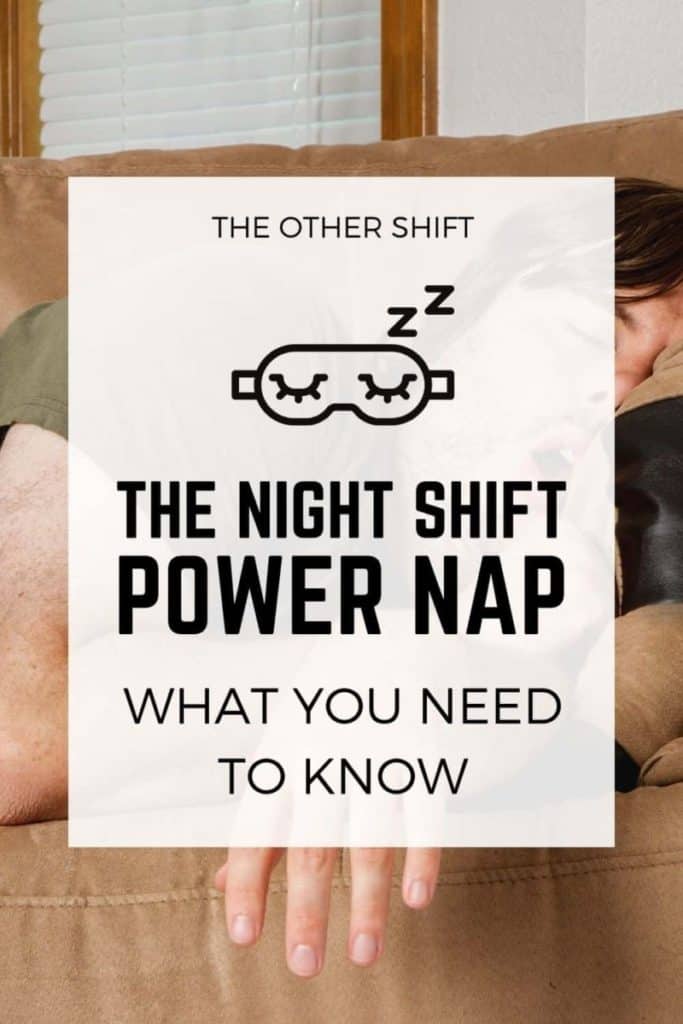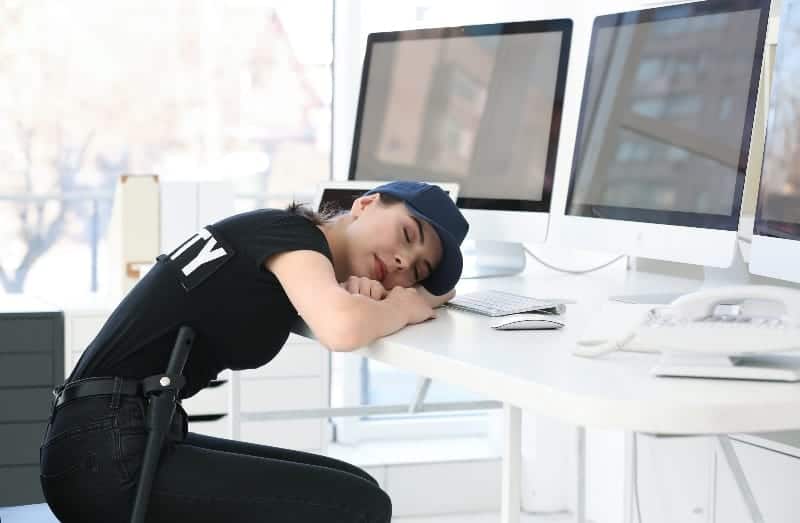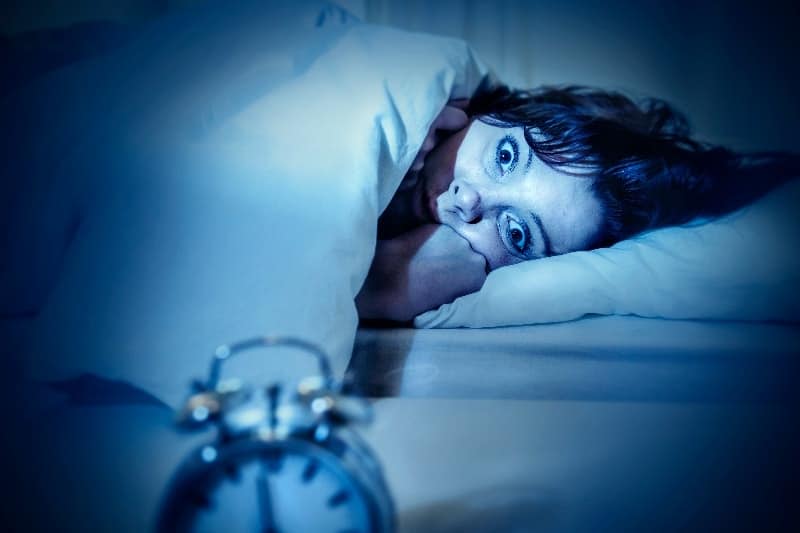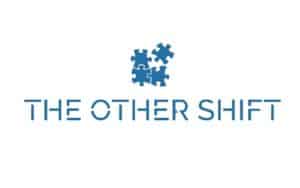If you have ever found yourself, halfway through your night shift, wistfully eyeing a couch that is just begging you to take a power nap, this article is for you. Night shift related fatigue stems from the fact that we are actively fighting our body’s circadian rhythm, so is it better to give in and take a power nap or fight through the drowsiness?

Multiple studies have confirmed that short power naps may benefit people working night shifts because they reduce the natural sleep pressure caused by a circadian low point that occurs between 2 am and 6 am. Benefits of this include, increased alertness, memory, productivity and problem-solving abilities.
Certainly, naps are not going to work for everyone, but if you would like to join a growing movement of people intentionally snoozing at work, we are going to make sure you have all the information you need to take the best nap of your life while working the night shift.
The Night Shift Power Nap: What You Need to Know
There are a number of compelling reasons to sneak in a mid-shift power nap. For example, surveys have shown that night shift workers are 60% more likely to experience fatigue, or even fall asleep on the job over their day shift counterparts.
This is because our bodies are programmed to respond to the gradual build-up of a homeostatic drive to sleep, otherwise known as “sleep pressure.” That sleep pressure peaks between 2am and 6am, which explains why night shift workers have to fight so hard not to feel sleepy; it is literally the body’s default setting.
This sleep-inducing setting can have dangerous consequences for night shift workers who are at an increased risk of fatigue related symptoms including:
- Higher incidents of human error
- Accidents and injury
- Motor vehicle accidents
- Involuntary sleep
These can be serious issues for many night shifters in safety-critical occupations, but how are naps supposed to help?
Well, it has been scientifically proven that built up sleep pressure decreases rapidly at the onset of sleep. Meaning that even a short nap can significantly decrease the pressure night shifters feel to fall asleep, effectively banishing the extreme sleepiness they experience in addition to other benefits.
Although, a nap is never a replacement for a good night’s sleep or proper sleep hygiene.

The Benefits of a Night Shift Nap
There are a number of benefits associated with power napping that night shift workers stand to profit from, other than just increased alertness and productivity. We’ll briefly explore a few of those here.
- Better Memory: It can be hard to think when you’re sleepy. A 2008 study found that power naps increase verbal recall and learning retention. Whereas, caffeine can actually impair these cognitive functions.
- Blood pressure regulation: Researchers found that a power nap can lower blood pressure, partly because it gives your body a chance to cope with stress.
- Mood regulation: According to The Sleep Foundation, taking a quick nap may also help you hit an emotional reset button if you’re having a rough go of a shift.
The Data: Night Shift Power Napping
According to data that NASA collected in 1995, Pilots who took a 10 to 40 minute power nap demonstrated significantly improved performance and vigilance. The aviation industry took this information seriously and have since incorporated napping into the fatigue management strategies for safety-critical work groups like pilots, flight attendants, mechanics and air traffic controllers.
Power Nap Fun Fact: Did you know pilots and flight attendants have hidden bunks where they go to take power naps? Flight crews have access to these spaces during trans-oceanic or red-eye flights, which tend to be the airline equivalent of a night shift. Depending on the aircraft they are usually located above or below the main passenger cabin.
More recently, a study in 2017 set up napping pilot programs in six different hospital units. The nurses involved in the study reported feeling less drowsy after a nap and felt safer driving home after their shift. While, a 2006 study reported that 10 out of 13 nurses who participated in a nap study reported increased energy, improved mood and enhanced decision-making after taking a power nap.
Overwhelmingly the data spoke in favor of napping but there were a few important caveats:
- Power napping exacerbated insomnia among night shift workers who already struggled to get enough sleep outside their shift.
- The sleeping environment for napping did impact the quality of power naps.
- The success of a workplace napping program depended on the culture of the shift. If people stigmatized naps, it was not as productive to power nap.
With these in mind, let us explore the things that can make, or break, a night shift power nap.

Timing Matters
The benefits you reap from napping on night shift are a matter of when you nap and how long you sleep.
If you sleep too late in your shift, you risk making it harder to sleep when you go to bed. And if you sleep too long during your break, you might end up waking up feeling sleepier than you did before.
Nap Timing
If you want to incorporate a power nap into your night shift, it is better to nap proactively during the first half of your shift, rather than wait for the fatigue to catch up with you. It might seem counter intuitive to nap before you feel tired, but there are a few reasons this approach is best.
First of all, the goal of a power nap isn’t to fall deeply asleep. Falling too deeply to sleep during a nap can cause you to wake up feeling groggier than when you laid down.
Taking your power nap before you get super fatigued will help prevent this from happening. The actual goal of a power nap is to reduce the build-up of sleep pressure. This will happen no matter when you take a nap and ultimately delay the peak of your sleep pressure until you are safely home and tucked in bed.
To this end, if you take your power nap too late during your shift you will essentially be pushing the peak of your sleep pressure back too much, causing you to lie awake when it is time to get the good night’s sleep you were looking forward to.
This means, depending on how your break-time is structured, you may want to opt for an earlier break in order to sneak that power nap in before it gets too late.
Nap Fun Fact: The best time to nap is right in the middle of your wake cycle. Researchers at the University of California-Berkeley recommend napping approximately eight hours after you wake up, and about eight hours before you go to sleep, assuming the average human is awake 16 hours per day.

Nap Length
A power nap is meant to be a short nap, with longer naps often contributing to the development of “sleep inertia,” which will leave you feeling sleepy.
To understand sleep inertia, think about a power nap like floating on a lake. The deeper you sink, the deeper you are falling asleep and once you’ve sunk so far, it’s going to take longer to get to the surface and you are going to be pulled into the deeper parts of the sleep lake.
Dr. Sara Mednick, a sleep scientist at the University of California Riverside says that a 10 to 30 minuet nap is ideal. Her findings verify the findings of the 1995 NASA study that we mentioned above, which found that a 25.8 minute nap was the average nap length among the pilots who demonstrated increased alertness.
There are benefits to longer naps, which should be taken in intervals of 30-minutes, (i.e. 60 or 90 minutes), but those naps are best taken before your night shift and do not constitute as a power nap.

Environment Matters
It is hard to nap in busy, loud and / or brightly lit spaces. It can also be hard to nap if you can’t lie down, or at the very least, recline.
You’ll get the most of your power nap if you can go to, or create, a relaxing environment.
Nap Rooms
Some employers will provide nap rooms for their employers. These are rooms with couches, cots, or recliners that are kept quiet and dimly lit so employees have the opportunity to lie down during their breaks.
This may seem like a luxurious amenity reserved for Silicon Valley, but they have been pretty standard for some traditional shift-work industries too.
- First responders: Firefighters and paramedics often have nap rooms at their stations, so they can lie down between calls, especially during overnight shifts.
- Flight Crews: Most of the big airline bases have nap rooms in their operations areas for pilots and flight attendants to use between flights.
- Air traffic control operators: In the United Kingdom ATC operators are required to take a 30-minute break every two-hours. At Swanwick there is even a dormitory.
- Truck drivers: Okay, they don’t really have a room but there is usually a bunk built into the cab of the truck, so drivers can take naps when they feel sleepy.
Nap Fun Fact: The Ben and Jerry’s headquarters in Vermont have a nap room set up. They call it “the Da Vinci Room.”

Create a Nap Space in Your Car
If your employer is not providing a nap space, no worry, you can create your own. Your car may be a perfect place to do this. All you really need is an eye mask and a blanket, but if you want to make a nap oasis in your ride, we have a few product recommendations for you.
- A Car Air Mattress: Car air mattresses like this one transform the back seat of your car into a perfect place to lie down. We recommend adding your favorite pillow, instead of using the blow-up ones included. Throw a few cozy blankets on top and you have your own, portable nap room.
- Magnetic Window Shades: These magnetic window shades go up quick, providing you with a little privacy from nosy parking lot goers.
- A Car Diffuser: A car diffuser creates a relaxing oasis in your vehicle. Simply add your favorite aromatic essential oil. Bonus: you can plug this in at your desk if you like.
In addition to these items, we also recommend downloading a white noise app to use on your phone to drown out the noises from outside your car. We do not recommend putting headphones in if you opt for a car nap, for safety reasons.

Create a Nap Space Anywhere
If you rely on public transportation to get to work, or don’t feel safe sleeping in your car, you may want to invest in a few of these travel-inspired sleep items that will make it possible for you to power nap, anywhere.
- A good neck pillow: That neck pillow you take on vacation with you is great for your night shift power nap too. You can use it in a recliner, on the breakroom couch, or at your desk. But if you have to sleep at your desk, we suggest investing in this innovative pillow.
- A compact blanket: Compact blankets designed with campers in mind are great to take with you to work. They won’t take up too much space in your bag or locker.
- A blackout eye mask: Black out eye masks that have a contoured design are comfortable and won’t mess up your eye makeup so much (if that’s a concern of yours). When make-up isn’t an issue we love the eye mask from Swanwick Sleep Dan and I are wearing below.
Now all that is left is to plug your headphones in and turn on that white noise app.
Nap Fun Fact: There is a company called MetroNaps that created an EnergyPod, which is the corporate answer to a nap environment. The pod costs a cool $12,985 and comes with its own sound system that comes pre-programed with mediations, massage settings, and app-controlled lighting. These space capsules of rest can be found in hospitals and airports, so if you’re working a night shift and your company has one, go test it out.
For a cheaper but effective nap option, check out the Alvantor Bed Canopy Bed pictured below.
pictured below.
Company Culture Matters
Napping on the job is not necessarily a new or radical concept. There are a number of countries that have long normalized napping at work within their wider cultures. But in the United States one of the biggest barriers to night shifters napping was the workplace culture.
In the studies we consulted, there were two main types of cultural barriers that made it difficult for night shift workers to nap.
- First, there was a general stigma around napping: One study found that people in the US have internalized guilt when it comes to napping. They are afraid of appearing lazy, or do not believe that management could support at-work power naps. This created a barrier when a night shift napping program was set up because the affected people refused to nap.
- The second barrier was only observed in nurses, so nurses pay attention! In a study conducted at a hospital in Australia, nap programs were unsuccessful during the night shift because 45% of the working nurses chose not to take a break at all. Interestingly, the nap program was successful for the day-shift nurses because only 6% of nurses refused their breaks.
Culturally speaking, the Nurses felt that they were being unfair to their colleagues by taking their breaks. To solve the problem, management took initiative to have nurses agree upon a break schedule each night which helped lighten the stigma around breaking. They also provided a sleeping place for the nurses to use during their turn to break.
Nap Fun Fact: There is a word for napping at work in the Japanese language: “inemuri,” which translates to “sleeping while present.”

The Times, They Are a Changing
Nap stigma is still far more present in the culture of the United States than it is in other countries like Spain, Italy, or even China. But the US may be beginning to realize that naps at work are beneficial.
Perhaps that’s because someone finally realized that a 20-minute nap costs the same amount of time as a 20-minute coffee run, or maybe it’s because they realized it actually pays to pay people to nap. According to the National Safety Council, fatigue-related productivity losses cost industries over $136 billion every year.
What does this mean for night shift workers? It means there has never been a better time to float the idea of break-time naps.
Your Headspace Matters
Stress can interfere with your sleep and that goes for power napping too. If you bring any kind of stress to your nap, you’ll probably end up spending your designated nap time worrying about something instead of resting your body and mind.
If you are having a hard time banishing your worries here are a few tips recommended by The Sleep Foundation.
- Practice a breathing exercise: Breathing exercises are restorative and help us release pent up stress from our bodies. Doing a quick two-minute guided breathing exercise at the beginning of a power nap can help you relax. Most smart watches have one already pre-programed into their fitness app.
- Set a nap intention: Keep in mind what you hope to gain from your nap.
- Listen to a guided sleep meditation: There are tons of apps on your phone that can grant you access to free guided relaxation and sleep meditations that can be a great addition to your power nap routine.
Nap Fun Fact: You don’t have to fall asleep to get some benefit out of a power nap. Simply taking the time to lie down and close your eyes for 20 minutes can help your body cope with the stresses of the night shift because it has been shown to lower your blood pressure and help you cope with stress.

Caffeine Matters
We’ve mentioned the Coffee Nap before, but it really is an effective strategy for night shifters to use when power napping.
To master the coffee nap all you have to do is drink a cup of coffee or the caffeinated beverage of your choice and then go lay down for your 10 to 20-minute power nap. When you wake up your sleep pressure will be reduced, and you will be reaping the cognitive benefits of your coffee too.
But be sure not to perform the coffee nap within eight hours of your bedtime. This type of power nap is strictly to be used at the beginning of your shift, otherwise you run the risk of interfering with your sleep later on.
Nap Fun Fact: 85% of mammalian spices are polyphasic, meaning they sleep multiple times a day, whenever they feel sleepy. Humans are typically monophasic, meaning they tend to sleep in one big chunk. But scientists are not sure if that is natural or if we have just decided to be that way.
VIDEO – Caffeine and Night Shift: Creating The Perfect High
Final Thoughts About The Night Shift Power Nap
To recap, scientific studies have shown that a night shift power nap can aid in reducing fatigue by alleviating the natural build-up of sleep pressure. They can help night shifters feel more alert and increase the cognitive functions necessary to do well at work. Power naps have also been attributed to lower blood pressure, improved moods and weight management.
We were left with the impression that a power nap might be the thing every night shifter needs, but that is probably not the case. As we mentioned above, power napping during your night shift can exacerbate insomnia, if that is something you struggle with.
Furthermore, you shouldn’t need a power nap each shift. If you feel yourself getting that fatigued every night, it may be time to take a closer look at your overall sleep hygiene and try to make sure you are getting 7-9 hours of high quality, uninterrupted sleep in a 24-hour period.
We hope you found this open, honest discussion of power napping during the night shift useful.
Want more? Take a look at this post – Do Naps Count as Sleep or Are You Wasting Your Time?

Sources:
- Fry, Alexa. “Napping.” Sleep Foundation. Oct. 9, 2020. Web.
- Weir. Kristen. “The Science of Naps.” American Psychological Association. Vol. 47. 2016. Web.
- Dvorsky, George. “The science behind power naps, and why they’re so damn good for you.” Gizmodo. Sept. 23, 2013. Web.
- Banks, Siobhan, Charlotte Gupta, and Stephanie Centofanti. “Power naps and meals don’t always help shift workers make it through the night.” The Conversation. Sept. 13, 2017. Web.
- Brown, Jeanne Geiger, et.al. “Napping on the Night Shift: A Two-Hospital Implementation Project.” American Journal of Nursing. Vol. 116. 2016. Web.
- “Benefits of napping on night shifts.” Nursing Times. Nov. 4, 2011. Web.
- Eriksson, Malin. “Mastering the art of the power nap.” Sleep Cycle. Jul. 14, 2020. Web.
- Cooper, Belle. “How Naps Affect Your Brain and Why You Should Have One Every Day.” Buffer. Jul. 25, 2013. Web.
- Knight, Laurence. “How to nap successfully at work.” BBC. Jan. 10, 2017. Web.
- Herrera, Tim. “Take Naps at Work. Apologize to No One.” The New York Times. Jun. 23, 2017. Web.
- Alger, Sara, et.al. “Challenging the stigma of workplace napping.” Sleep. Vol. 42. Aug. 2019. Web.
- Zimmerman, Kaytie. “It’s Time to Start Taking Naps at Work.” Forbes. Feb. 1, 2018. Web.
Recent Posts
An examination of the night shift professions, that while sometimes underappreciated, are necessary for civilization, in its current form, to exist. A city can be thought of as a machine. Each...
Culminated from an exhaustive yet well-funded journey into the night, this article will prepare you for life outside of work while being a denizen of the dark. During days off, night shift...


